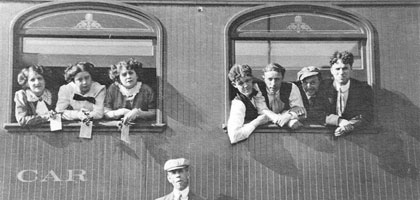Already a Star With Karno
1908-1913

On 9 July 1906 Sydney Chaplin signed a contract with Fred Karno, the outstanding comedy impresario of the British music hall. Karno (1866-1941) had developed a remarkable production system. In his "Fun Factory" he trained his artists, wrote and rehearsed the sketches and created the scenery and costumes. At any one time he would have several different companies touring the music halls.
With his skill as a performer and comedy writer, Sydney Chaplin rapidly became a star of the Karno sketches, and in February 1908 asked Karno to take on his young stepbrother Charlie. Karno could not at first see the comic possibilities of this shy, quiet, handsome youth; but after a short trial period gladly gave him a contract (21 February 1908), which was to be renewed for three further years in September 1910. Charles played the leading roles in Karno's sketches Mumming Birds, The Football Match and Jimmy the Fearless. In style and structure these sketches, mostly done in mime, were remarkably like early one-reel comedy films.
Chaplin's exceptional gifts were immediately evident: a critic of 1912 already described him as a "genius" of comic creation. In September he was chosen to star in a Karno company tour of North America. The tour lasted from September 1910 to June 1912, and his fellow-artists in the troupe included a young Lancashire comic, Stanley Jefferson, the future Stan Laurel.
Away from Karno's supervision, Chaplin had more scope to reveal his creativity in making over what he regarded as inferior comedy material, and introducing new features to the act. He was astonished and thrilled by the New World, as the company criss-crossed the continent from New York to California, and the return to Europe seemed an anticlimax. After four months at home, he was glad to embark on a second American tour in October 1912.
At some point on this second tour, he was spotted on stage by a representative of the newly-formed Keystone Film Company: in later years Mack Sennett, Keystone's production chief, claimed that it was he, along with the company's leading lady Mabel Normand, who had seen Chaplin on stage in New York. In the spring of 1913 Chaplin was asked to contact Kessell and Baumann, Keystone's parent company in New York, and on 23 September 1913 signed a year's contract to work with Keystone. His salary was $150 per week.